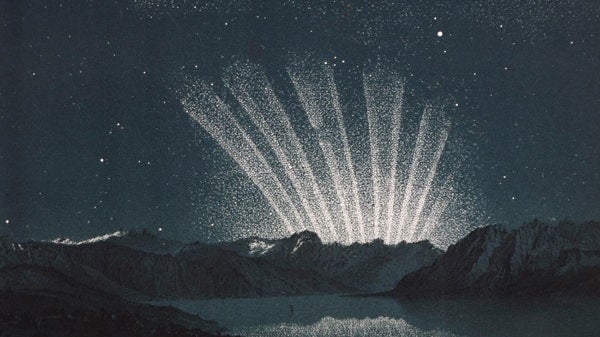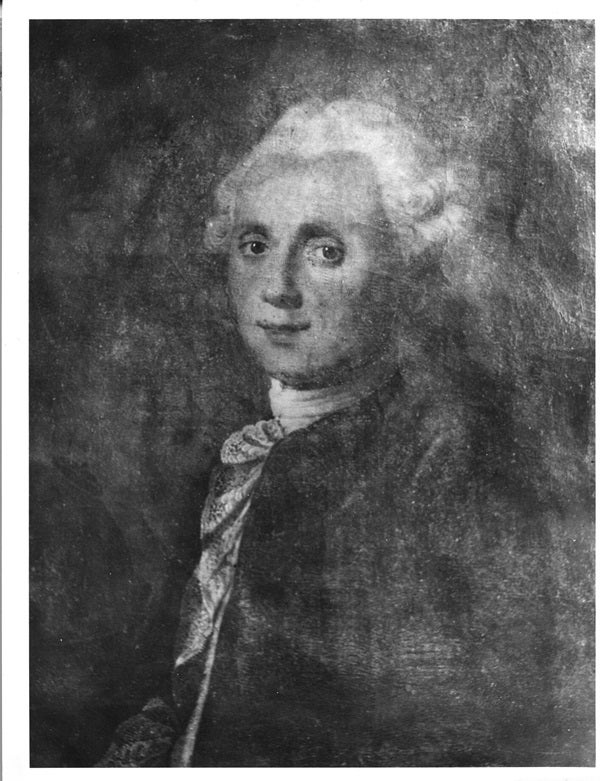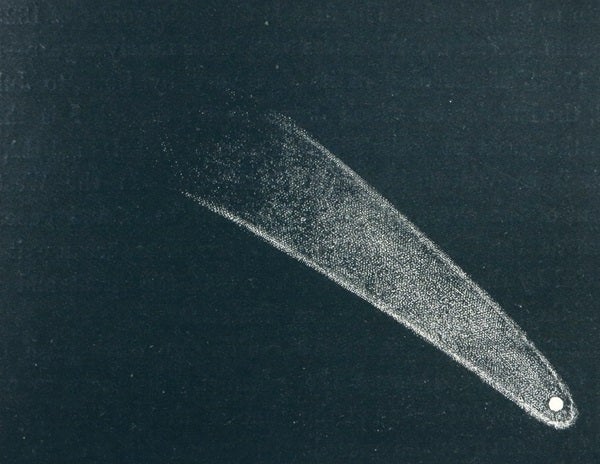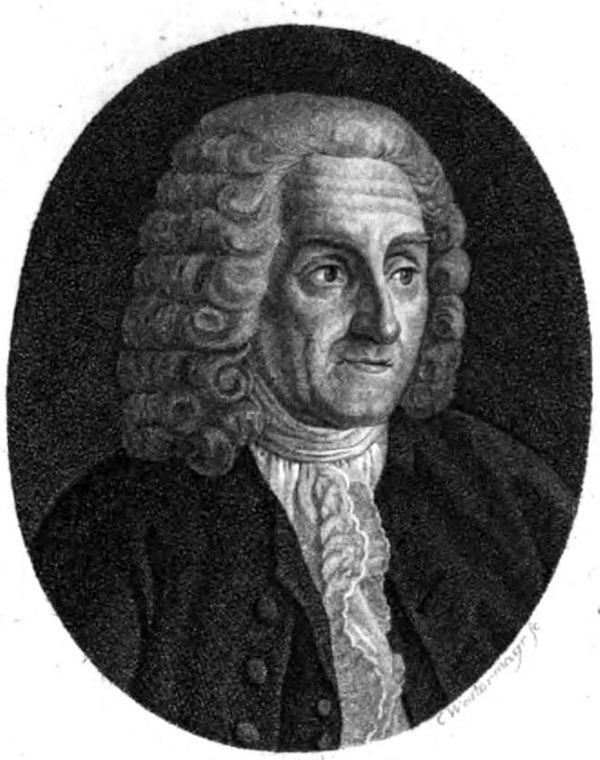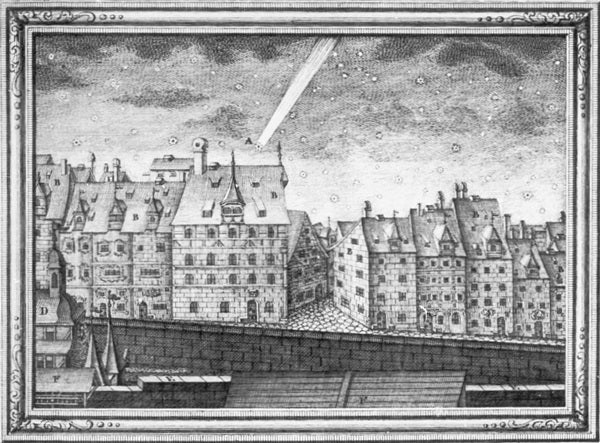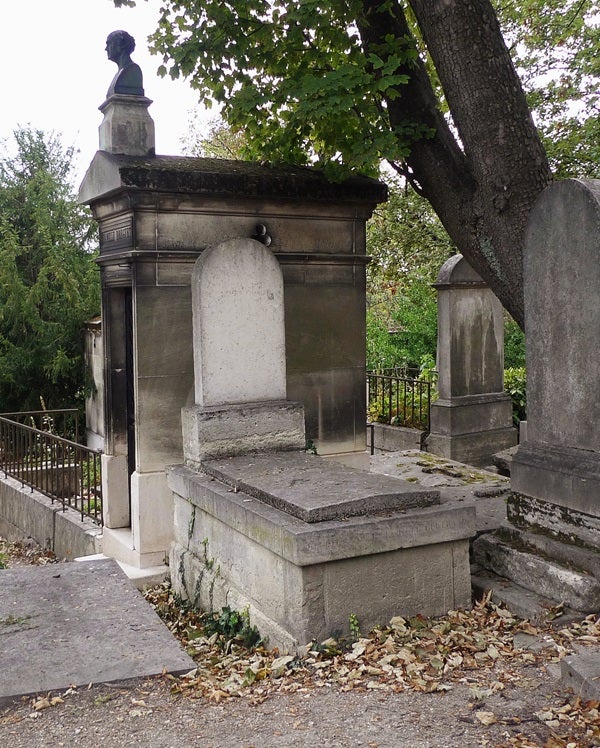De Chéseaux’s Comet, also known as the Great Comet of 1744, probably was young Charles Messier’s first great astronomical sight. The drawing above lets you compare some of the methods astronomers and artists used to record the visitor. Both illustrations show the comet’s six tails even though its head still lies below the horizon, but the one above includes a realistic star field. The bright star a bit to the right of the comet near the top of the image is Altair (Alpha [α] Aquilae).
nearly everyone would respond that he produced a catalog of 109 deep-sky objects. A few might say that his catalog helps observers distinguish between comets and stationary background objects.
But if I were to push harder and ask, “How many comets did he discover?” or “What were his most famous comet discoveries?” few could answer these simple questions. It now seems that history has pigeonholed Messier, who is far better known for his list of “non-comets” than being the greatest comet hunter of the 18th century. Even today, few biographies discuss the merit of Messier’s numerous discoveries. It’s past time to rectify this error.
Charles Messier’s love of astronomy, and especially comets, began as he grew up in Badonviller, France. Born June 26, 1730, as part of a large and moderately affluent family, Messier received a well-rounded education that included private tutelage by his older brother after their father died in 1741. What really sparked his interest in astronomy was the appearance of the Great Comet of 1744, often called de Chéseaux’s Comet after its discoverer, Jean-Philippe de Chéseaux.
A spectacular “comet of the century,” it was similar in brightness and appearance to Comet McNaught (C/2006 P1), which you may remember. At one point, de Chéseaux’s Comet sported a tail more than 60° long and shone as bright as Venus. In late March 1744, observers reported seeing six tails — actually the most visible parts of a single huge, curved dust tail — while the coma was well below the horizon.
Young Messier also observed the annular eclipse on July 25, 1748. From his vantage point in northeastern France, however, it was a partial eclipse with an obscuration of about 74 percent.
In 1751, Messier, now 21, headed off to Paris to find work. With the help of his older brother, he landed a position working with Joseph-Nicolas Delisle, an astronomer in the French Navy. From Delisle, he learned to make detailed observations and determine exact astronomical positions, a skill that proved to be invaluable in comet hunting and putting together his famous catalog.
Messier’s first real test came when making detailed observations of the May 6, 1753, Mercury transit. By 1757, a great deal of excitement was building in the astronomical community with the first predicted return of Halley’s Comet. Armed with Delisle’s positional calculations, Messier soon set off to be the first to recover the comet using a 4½-foot focal length Newtonian reflector. What he didn’t know was that Delisle’s positional data contained errors, leading Messier to search the wrong sections of the sky.
While conducting routine sweeps for Halley on August 14, 1758, Messier found a faint patch of light that had no nucleus but appeared strongly concentrated. He had independently discovered Comet De la Nux (C/1758 K1). Though not credited with the co-discovery, he made more than 30 observations of the comet until it faded from sight November 2. During another sweep for Halley, he discovered a small patch of light in Taurus that showed “no movement.” He later designated this object M1. We know it as the Crab Nebula, the first entry of his famous catalog.
Eventually, Messier did recover Halley’s Comet on January 21, 1759, about a month after the initial recovery by German astronomer Johann Georg Palitzsch on Christmas Day, 1758. Had Messier realized earlier that Delisle’s calculations were in error he might have been the first to recover it, rather than coming in second.
Messier described it as “a faint glow resembling the comet I had observed earlier in the previous year.” However, and for whatever reason, Delisle deliberately delayed publishing Messier’s observations of Halley’s Comet until April 1, which caused tension between the two astronomers. The comet remained a challenging object to observe until it emerged from the twilight in late March. Although primarily a southern object, by May it afforded splendid views for northern observers. It reached at least 1st magnitude with a tail 47° long.
Discoveries
On January 8, 1760, Messier co-discovered the Great Comet of 1760 (C/1760 A1), a bright 2nd-magnitude object located near the sword of Orion. It also became one of closest comets to approach Earth, coming to within 6.34 million miles (10.2 million kilometers). But once again, Delisle delayed in publishing Messier’s observations.
Tensions between Delisle and Messier finally waned when the aged astronomer retired in 1765. Soon, other astronomers across the globe were taking notice of the quantity and quality of Messier’s astronomical observations. The discoveries and observations he made through the rest of the decade would bring him fame and professional recognition.
Following his discovery of C/1760 B1, he found several more comets with the modern designations of C/1763 S1, C/1764 A1, and C/1766 E1. He swept the first one up through the 1-foot scope, while the second one was already 3rd magnitude when he spotted it with unaided eyes on January 3, 1764. It would later prove to be a fine sight through a small scope. It sported a bright coma and a well-defined 2° tail.
The third of these comets was an accidental discovery Messier made while searching for a rumored satellite of Venus. He detected a faint glow in one of his sweeps some distance from the planet. Though not a particularly pretty comet, it was still barely visible with the naked eye. It seemed that his luck had truly changed, as he was finding new comets even when not actively sweeping for them. But the best was yet to come.
Throughout history, astronomers have labeled some comets “great,” but few can compare with one Messier discovered on August 8, 1769. That night, he observed a faint patch of nebulosity only a few arcminutes across. But it brightened quickly; by the 15th, it had a tail 6° long, and skywatchers could easily see the coma with their naked eyes. A bright Moon would interfere with observations until the end of the month, but by early September, the comet rapidly brightened. Messier noted the growth of the tail, from 36° on September 3 to more than 60° on the 9th, while the slightly reddish coma was about 1° in diameter and as bright as a zero magnitude star.
Sightings of this comet’s grandeur came from across the globe, with astronomers Alexandre Guy Pingré and Jean Baptiste de la Nux reporting a doubly curved tail spanning 90° to 98° on the day of the comet’s closest approach (September 10, 1760). The tail maintained impressive lengths for several more days before morning twilight overwhelmed it.
On October 8, the comet reached perihelion and emerged from the evening twilight. It had lost a great deal of its brilliance, but the coma was still as bright as a 3rd-magnitude star and had a 6°-long tail November 1. In many ways, the evolution of the tail of this comet resembled that of a modern-day one that Astronomy readers may remember: Comet Hyakutake (C/1996 B2). In 1775, Messier would write a journal article complete with drawings and a chart of the comet’s orbit.
Messier’s next comet discovery turned out to be anything but normal. He found it June 14, 1770, but the Finnish-Swedish astronomer Anders Lexell computed its orbit — hence C/1770 D became known as Lexell’s Comet. It’s famous for coming closer to Earth than any comet in history, a mere 1.37 million miles (2.2 million km) away. At its closest, the 2nd-magnitude coma spanned 2.4° and was moving across the sky at 42° a day, much like the motion of a more recent object, Comet IRAS-Araki-Alcock (C/1983 H1).
It was also the first comet in modern times to become “lost.” A short-period comet with an orbit of 5.58 years, in 1767 and 1779 it made close passages by Jupiter, which either ejected the comet from our solar system or moved it into a much longer period orbit. Studies of this comet by Lexell, French astronomer Urbain Jean Joseph Le Verrier, and others helped lay the foundations of orbital dynamics and gravitational perturbations.
The next several years became a whirlwind of discovery, accolades, and life events. Messier would get married, be accepted into the French Academy of Sciences, and discover three more comets. It was during this period that King Louis XV gave him the nickname the “Ferret of Comets.” In 1774, he was introduced to Pierre Méchain, an ambitious young astronomer and comet hunter. Méchain would soon become his fiercest comet-discovery competitor, finding eight comets (and three additional co-discoveries), but he would also always remain a close friend, and even helped Messier compile his catalogs of non-comets.
As the 18th century was drawing to a close, comet hunting was becoming much more popular. The spacing of Messier’s next comet discoveries (1780, 1785, and 1788) reflected the increased competition. But nothing would affect the state of French astronomy more than the unrest of the French Revolution.
During the Reign of Terror (September 6, 1793, to July 28, 1794), the French Academy of Sciences disbanded, many observatories shut down or lost their funding, and Messier lost both his navy salary and Academy pension. Yet, even with all the violence and social unrest, Messier discovered a faint comet September 27, 1793.
Soon things began to settle down. The new emperor, Napoleon Bonaparte, looked favorably on science. Méchain became the new director of the Paris Observatory, and both he and Messier were admitted into the new Academy of Sciences. In 1798, Messier would make his last independent discovery of a comet. Then in 1801 he made his last co-discovery, with Méchain and a new comet hunter extraordinaire: Jean-Louis Pons, who would go on to find 37 comets, a record that still stands.
During the early 19th century, Messier added to his already impressive total of comet observations, making valuable contributions for a few more years. In 1806, Napoleon presented Messier with the Cross of the Legion of Honor, which he wore with enormous pride.
Not long after, the Great Comet of 1807 blazed across the sky. The object marked Messier’s last detailed observations of a comet, this time with a scope of 2 meters focal length. Now 77, and with failing eyesight, he could no longer work for the observatory. Although he lived another decade, it’s not certain that he even observed the Great Comet of 1811, which set a record for naked-eye visibility (260 days) that wasn’t broken until Comet Hale-Bopp’s appearance in 1997.
Legacy
The Comet Ferret would suffer a debilitating stroke in 1815, and die April 12, 1817, at the age of 86. Charles Messier left an amazing legacy of observation, discovering 13 comets and co-discovering seven more, a total of 20. Perhaps even more incredible is that he made detailed observations of no fewer than 44 out of the 50 known comets from 1758 to 1805.
Messier refined the art of comet hunting by preferring short focal-length telescopes of small aperture (generally less than 4 inches) for his sweeps. He took meticulous notes and positional measurements of everything he observed, even of those pesky non-comets. And though perhaps better known now for his catalog of deep-sky objects, he will always be remembered as one of the greatest comet hunters of all time.

